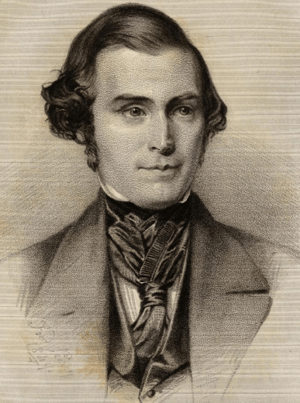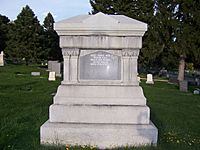Orson Pratt facts for kids
Quick facts for kids Orson Pratt |
|
|---|---|
 |
|
| Quorum of the Twelve Apostles | |
| January 20, 1843 – October 3, 1881 | |
| Quorum of the Twelve Apostles | |
| April 26, 1835 – August 20, 1842 | |
| LDS Church Apostle | |
| April 26, 1835 | |
| Reason | Initial organization of Quorum of the Twelve |
| Reorganization at end of term |
George Teasdale and Heber J. Grant ordained to replenish the Twelve |
| Personal details | |
| Born | September 19, 1811 Hartford, New York, United States |
| Died | October 3, 1881 (aged 70) Salt Lake City, Utah Territory, United States |
| Resting place | Salt Lake City Cemetery 40°46′37.92″N 111°51′28.8″W / 40.7772000°N 111.858000°W |
Orson Pratt Sr. (born September 19, 1811 – died October 3, 1881) was an American mathematician and a leader in the Church of Jesus Christ of Latter-day Saints (LDS Church). He was one of the first members of the Quorum of the Twelve Apostles, a top leadership group in the church. Pratt was also a very important writer and thinker for the church until he passed away.
Contents
Joining the Church and Serving Others
Orson Pratt was born in Hartford, New York. His older brother, Parley P. Pratt, introduced him to the LDS Church. Orson was baptized on his nineteenth birthday, September 19, 1830, in Canaan, New York.
Early Church Roles
Just a few months later, on December 1, 1830, Joseph Smith made Pratt an Elder. Pratt immediately went on his first mission to Colesville, New York. This was the start of many short missions where he preached in New York, Ohio, Missouri, and other eastern states. On February 2, 1832, he became a High Priest and continued his missions across several states.
Becoming an Apostle
In 1835, Joseph Smith chose Orson Pratt to be one of the first members of the Quorum of the Twelve Apostles. He was given this important role on April 26, 1835. From 1839 to 1841, he served as a missionary in the British Isles. While there, he preached in Scotland and wrote an important missionary pamphlet. This pamphlet, called "An Interesting Account of Several Remarkable Visions," was one of the first to describe Smith's First Vision.
Challenges and Rejoining
When Pratt returned to America in 1841, he found the church facing many disagreements. There were rumors in Nauvoo, Illinois, and Pratt struggled with some new church teachings. He was briefly removed from the church on August 20, 1842. However, Pratt soon made up with Joseph Smith and asked to be baptized again. He was welcomed back into the Quorum of the Twelve Apostles on January 20, 1843.
Working with Brigham Young
After Joseph Smith died, Orson Pratt supported Brigham Young as the new leader. Young decided to move the church members from Nauvoo to the Salt Lake Valley. Pratt helped gain support for Young's leadership among the church members.
Pratt and Young sometimes had different ideas about church teachings. Young often sent Pratt on many missions, which some believe was to reduce Pratt's influence. However, after Young's death, Pratt's ideas became more important to other church leaders.
Missionary Journeys
After settling in the Salt Lake Valley, Pratt was asked to return to Europe as a mission leader from 1848 to 1851. During this time, he also edited the Millennial Star newspaper. In 1850, as the leader of the British Mission, Pratt encouraged his missionaries to spread the gospel widely. By the end of that year, there were twice as many church members in Britain as in the United States. Missionaries admired Pratt for his clear and logical writings about theology.
In 1865, Pratt was one of the first church missionaries to work in Austria. He stayed there for nine months but was eventually asked to leave by the Austrian government.
Journeying West
When Orson Pratt heard the church was moving west, he wanted every member to join the journey. He helped lead the "Vanguard Company" across the plains to find a new home for the church. His journals from this trip are a valuable source of information about Mormon history.
As the group traveled, Pratt was the company's scientist. He used instruments to take readings, wrote notes about rocks and minerals, and recorded information about plants and animals. He even noted snow on Laramie Peak in June.
Inventing the Roadometer
Pratt, who was a mathematician, helped William Clayton design an early version of the odometer. This device was used to measure how far the wagons traveled each day. It had wooden gears attached to a wagon wheel that counted its rotations. This invention, called the "roadometer," was first used on May 12, 1847.
Pratt and Erastus Snow were the first to enter the Salt Lake Valley on July 21, 1847. This was three days before the main group arrived. A few days later, Pratt gave the first sermon in the valley and officially dedicated the area to the Lord.
Family Life
Orson Pratt had a large family. Some records say he had seven wives and forty-five children. Other sources, including his first wife, Sarah, say he had ten wives. At age 57, he married his tenth wife, Margaret Graham, who was sixteen.
Pratt and his family often faced financial challenges. This was partly because Brigham Young frequently sent him on missions, which limited his ability to earn money. However, Pratt supported his family by writing and publishing pamphlets about church beliefs. Some of his wives also earned money by selling goods.
In 1852, Orson Pratt gave a sermon that openly discussed the practice of plural marriage for the first time in the church. He defended this practice in his writings and throughout his ministry. Because of this, he was sometimes called "the apostle of polygamy."
Orson Pratt's Wives
- Sarah Marinda Bates
- Charlotte Bishop
- Adelia Ann Bishop
- Mary Ann Merrill
- Sarah Louisa Chandler
- Marion Ross
- Juliette Ann Phelps
- Eliza Crooks
- Sarah Louise Lewis
- Margaret Graham
Writer and Thinker
While in Illinois, Pratt taught mathematics at the University of Nauvoo.
In Utah, Brigham Young asked Pratt to write sermons and pamphlets about religious topics because of his strong writing skills. Pratt wrote sixteen pamphlets defending church teachings, using ideas from Joseph Smith and his brother Parley P. Pratt. These included "Divine Authority" (1848) and "Divine Authenticity of the Book of Mormon" (1850 and 1851). His pamphlet "An Interesting Account of Several Remarkable Visions" was the first published story of the First Vision.
Pratt's writings were mainly used for missionary work. He also became a church spokesperson on the topic of plural marriage. In August 1852, he publicly announced this teaching in a sermon in Salt Lake City. He later wrote a series of essays defending the practice in the church's magazine, The Seer. Pratt is considered one of the most important early defenders of the LDS Church.
Some of Pratt's ideas were controversial. In 1865, some of his writings, including articles from The Seer, were officially questioned by church leaders. They felt some of his ideas were misleading. However, many of Pratt's writings have still influenced modern church beliefs, such as ideas about God and the gathering of Israel.
In 1869, Pratt helped translate part of the Book of Mormon into the Deseret alphabet.
From 1874 until his death, Pratt served as the Church Historian and Recorder. He edited many church publications and helped organize the Book of Mormon and Doctrine and Covenants into verses with cross-references. He also served seven terms as the Speaker of the House in the Utah legislature.
Science and Astronomy
Pratt was a talented mathematician and was very interested in astronomy. He combined these subjects to form his own ideas about the universe, which are sometimes called 'early' Mormon cosmology. He gave science lectures to church members in Utah and published two books on these topics. His book New and Easy Method of Solution of the Cubic and Biquadratic Equations was published in 1866. Key to the Universe was published in 1879. His math book was even used as a textbook in other countries.
In October 1851, Orson Pratt taught mathematics at the 'Parent School' of the University of Deseret. He also gave a series of lectures on astronomy and its religious meaning. These lectures were part of an adult education program.
Published Books
- An Interesting Account of Several Remarkable Visions (1842)
- Absurdities of Immaterialism (1849)
- Cubic and Biquadratic Equations (1866)
- Key to the Universe (1866)
- The Bible and Polygamy (1870)
Death
Orson Pratt passed away at age 70 in Salt Lake City from complications of diabetes. He was buried in the Salt Lake City Cemetery. He remained an important writer and thinker for the church until his death. When he died, he was the last surviving member of the original Quorum of the Twelve Apostles called in 1835.
See also
 In Spanish: Orson Pratt para niños
In Spanish: Orson Pratt para niños
- List of people with the most children
- Quorum of the Twelve






